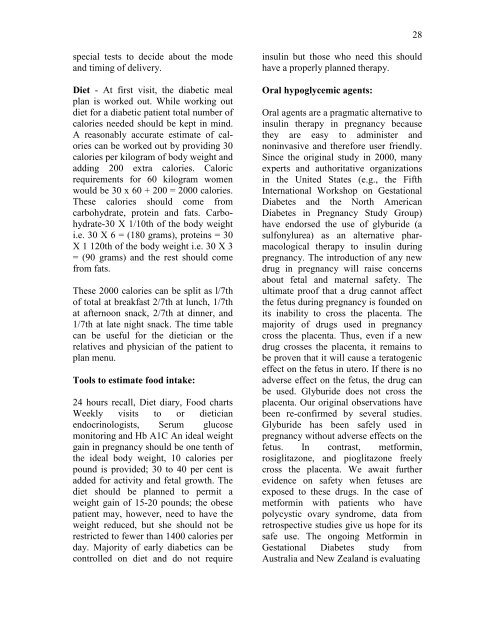Book of Medical Disorders in Pregnancy - Tintash
Book of Medical Disorders in Pregnancy - Tintash
Book of Medical Disorders in Pregnancy - Tintash
You also want an ePaper? Increase the reach of your titles
YUMPU automatically turns print PDFs into web optimized ePapers that Google loves.
special tests to decide about the mode<br />
and tim<strong>in</strong>g <strong>of</strong> delivery.<br />
Diet - At first visit, the diabetic meal<br />
plan is worked out. While work<strong>in</strong>g out<br />
diet for a diabetic patient total number <strong>of</strong><br />
calories needed should be kept <strong>in</strong> m<strong>in</strong>d.<br />
A reasonably accurate estimate <strong>of</strong> calories<br />
can be worked out by provid<strong>in</strong>g 30<br />
calories per kilogram <strong>of</strong> body weight and<br />
add<strong>in</strong>g 200 extra calories. Caloric<br />
requirements for 60 kilogram women<br />
would be 30 x 60 + 200 = 2000 calories.<br />
These calories should come from<br />
carbohydrate, prote<strong>in</strong> and fats. Carbohydrate-30<br />
X 1/10th <strong>of</strong> the body weight<br />
i.e. 30 X 6 = (180 grams), prote<strong>in</strong>s = 30<br />
X 1 120th <strong>of</strong> the body weight i.e. 30 X 3<br />
= (90 grams) and the rest should come<br />
from fats.<br />
These 2000 calories can be split as l/7th<br />
<strong>of</strong> total at breakfast 2/7th at lunch, 1/7th<br />
at afternoon snack, 2/7th at d<strong>in</strong>ner, and<br />
1/7th at late night snack. The time table<br />
can be useful for the dietician or the<br />
relatives and physician <strong>of</strong> the patient to<br />
plan menu.<br />
Tools to estimate food <strong>in</strong>take:<br />
24 hours recall, Diet diary, Food charts<br />
Weekly visits to or dietician<br />
endocr<strong>in</strong>ologists, Serum glucose<br />
monitor<strong>in</strong>g and Hb A1C An ideal weight<br />
ga<strong>in</strong> <strong>in</strong> pregnancy should be one tenth <strong>of</strong><br />
the ideal body weight, 10 calories per<br />
pound is provided; 30 to 40 per cent is<br />
added for activity and fetal growth. The<br />
diet should be planned to permit a<br />
weight ga<strong>in</strong> <strong>of</strong> 15-20 pounds; the obese<br />
patient may, however, need to have the<br />
weight reduced, but she should not be<br />
restricted to fewer than 1400 calories per<br />
day. Majority <strong>of</strong> early diabetics can be<br />
controlled on diet and do not require<br />
28<br />
<strong>in</strong>sul<strong>in</strong> but those who need this should<br />
have a properly planned therapy.<br />
Oral hypoglycemic agents:<br />
Oral agents are a pragmatic alternative to<br />
<strong>in</strong>sul<strong>in</strong> therapy <strong>in</strong> pregnancy because<br />
they are easy to adm<strong>in</strong>ister and<br />
non<strong>in</strong>vasive and therefore user friendly.<br />
S<strong>in</strong>ce the orig<strong>in</strong>al study <strong>in</strong> 2000, many<br />
experts and authoritative organizations<br />
<strong>in</strong> the United States (e.g., the Fifth<br />
International Workshop on Gestational<br />
Diabetes and the North American<br />
Diabetes <strong>in</strong> <strong>Pregnancy</strong> Study Group)<br />
have endorsed the use <strong>of</strong> glyburide (a<br />
sulfonylurea) as an alternative pharmacological<br />
therapy to <strong>in</strong>sul<strong>in</strong> dur<strong>in</strong>g<br />
pregnancy. The <strong>in</strong>troduction <strong>of</strong> any new<br />
drug <strong>in</strong> pregnancy will raise concerns<br />
about fetal and maternal safety. The<br />
ultimate pro<strong>of</strong> that a drug cannot affect<br />
the fetus dur<strong>in</strong>g pregnancy is founded on<br />
its <strong>in</strong>ability to cross the placenta. The<br />
majority <strong>of</strong> drugs used <strong>in</strong> pregnancy<br />
cross the placenta. Thus, even if a new<br />
drug crosses the placenta, it rema<strong>in</strong>s to<br />
be proven that it will cause a teratogenic<br />
effect on the fetus <strong>in</strong> utero. If there is no<br />
adverse effect on the fetus, the drug can<br />
be used. Glyburide does not cross the<br />
placenta. Our orig<strong>in</strong>al observations have<br />
been re-confirmed by several studies.<br />
Glyburide has been safely used <strong>in</strong><br />
pregnancy without adverse effects on the<br />
fetus. In contrast, metform<strong>in</strong>,<br />
rosiglitazone, and pioglitazone freely<br />
cross the placenta. We await further<br />
evidence on safety when fetuses are<br />
exposed to these drugs. In the case <strong>of</strong><br />
metform<strong>in</strong> with patients who have<br />
polycystic ovary syndrome, data from<br />
retrospective studies give us hope for its<br />
safe use. The ongo<strong>in</strong>g Metform<strong>in</strong> <strong>in</strong><br />
Gestational Diabetes study from<br />
Australia and New Zealand is evaluat<strong>in</strong>g


